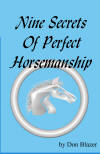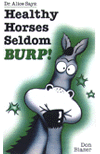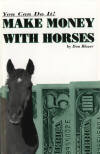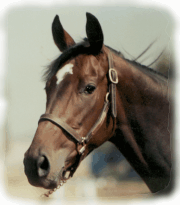
Don Blazer
Archives:
Flying Horses?
Don't eat like a Pig
Parasites
Back Sore?
Goat Hero
Communication
Foals
History of Horses
Jumping Horses
Lameness and Health
Kick the IRS
Meet Don Blazer
Books by Don Blazer
View Our Catalog
Secure Book Order Form
Don Blazer
A Horse, Of Course
Secure Book Order Form
Order using our Secure Order Form

Walter (A Horse, of Course) Spills the Oats
Nine Secrets of Perfect Horsemanship
This is a Secure Web Site
Archives:
Flying Horses?
Don't eat like a Pig
Parasites
Back Sore?
Goat Hero
Communication
Foals
History of Horses
Jumping Horses
Lameness and Health
Kick the IRS
Order using our Secure Order Form
View Our Catalog
This is a Secure Web Site
|
The more we know, the more complicated things become.
It used to be a horse was lame or he wasn't.
Not so today!
Today the horse may or may not be "suitable for the purpose intended." That's the way veterinarians get out of saying a horse is lame or he isn't lame. Most of the time vets don't perform "soundness" examinations. If the horse is having a problem, the owner, the trainer, or stable hand usually tells someone, and if the problem can't be resolved, the veterinarian is called. In some cases a veterinarian is called to do a "pre-purchase" examination.
The "pre-purchase" examination has given too many veterinarians the idea they are "all-seeing" or somehow have special gifts no one else possesses.
Too many veterinarians are costing horses useful, happy lives being partners with humans interested in a long-term relationship. Too many veterinarians are "failing" horses in pre-purchase exams when the horse's actual problems--often not even identified--can be managed and the horse can have a productive future.
There is no veterinarian who can tell you what is going to happen with a horse in the next 15 minutes, let alone the next 15 years. The results of a pre-purchase exam should be an explanation of what has been found, and how it can be managed. After that, the veterinarian should remain quiet. The decisions should be make by the potential buyer, not the veterinarian.
Any veterinarian who thinks he can see the future of a horse should be dismissed and replaced by a veterinarian who believes it is his job to see a problem, diagnosis a disease and aid in the restoration of health.
A horse is generally considered lame when pain (from whatever) causes him to alter the usual weight distribution on one or more limbs, or exhibit abnormal extension or flexion of a joint during movement.
The detection of lameness can be easy, while the diagnosis of lameness is often complicated, unless evident in an open wound.
If the average horseowner detects the lameness, that is usually sufficient. the veterinarian stands by with special knowledge, drugs, herbs or tools to make the diagnosis and plan treatment.
Slight lameness, especially in the hindquarters, is often best detected when the horse is in a stall. When Turning his forehand from side to side,
the horse with a spavin or stringhalt will shift his weight onto one hind leg more quickly than to the other, which may be considered the unsound limb. If the lameness is in the forehand, the horse will be reluctant to shift his weight onto the affected limb.
A horse"off" in the forehand will often "point" the affected limb. It is not uncommon for a horse to have one foot slightly advanced when standing quietly' however, if the horse is sound, both front feet will assume equal weight.
If the horse is "pointing," then the affected limb will be rested only on the toe, heel, or if kept flat, will not bear weight. A horse lame in one front foot usually stands with the pastern straighter than that of the sound leg.
When examining a horse in movement, it is best to trot the horse. The trot is a diagonal two-beat gait at which only two feet are grounded at the same time, and therefore, each bears more weight than at the walk. When trotting, a horse lame in a fore or hind leg will favor the unsound limb at the expense of its sound diagonal. If lame behind, he will often also appear lame in front since he will put more weight on the opposite foreleg from the unsound hind leg.
A lame horse will use his head and neck for balance and to relieve weight on the unsound limb. He will raise his head when the lame leg strikes the ground, bringing it more or less into normal position when the sound leg is grounded. This is called "head nodding lame," and it takes a severe lameness to cause it at the walk. It is much easier seen at the trot, especially if the handler has given the horse lead line freedom.
If the horse is lame behind, he will lower his head when the opposite foreleg is placed down.
If a horse is lame in both fronts or in both fronts and both backs, he will travel short and stiff and will lack freedom in placing his feet.
View the horse at the trot from behind. If the horse is off behind he will "hitch up" the unsound quarter in an attempt to keep weight off that side. Other signs of hind leg lameness are the dwelling on one foot longer than the other, or the higher lifting of one foot, or the dragging of a toe on the unsound foot.
When a horse is lame, check his feet. In most cases the cause of the lameness will be found there. If the direct cause is not found in the feet, the chances are still good a contributing cause is there.
A horse should be examined every day to make sure he isn't suffering some kind of problem. Unfortunately, we all fail to give that kind of care.
But, no horseman should fail to apply the rule "no pain" when a horse is being asked to work.
Horses are kind of like horsemen. If they are lame, they are lame, and need some fixin''.
And, if it ain't broke, don't be messing' with it.
Each month you'll find a new column on our web site. We hope you'll enjoy it, and maybe
e-mail us with questions or suggestions for other
columns. A Horse, Of Course is a weekly column syndicated
by Success Is Easy. If you like the column, call your local newspaper, or local horse
publication and ask them to subscribe by contacting Success Is Easy, 13610 N. Scottsdale Rd., Suite 10-406, Scottsdale, AZ 85254
________________________________
A Horse Of Course |
Horse Books Catalog |
Meet Don Blazer
Ask Don Blazer |
Courses and Clinics |
Horse Training
Horses for Sale |
Who's Walter? |
Horse Links
Home
Info@donblazer.com
Copyright © 2000 by
Don Blazer
Success Is Easy, 13610 N. Scottsdale Rd., Suite 10-406, Scottsdale, AZ 85254
Vanndal Web Designs


